Creating Variable Angle Drafts | ||||||
|
| |||||
Click Variable Angle Draft
 .
.
The Draft Definition dialog box that appears, displays the variable angle draft option as activated. If you click the icon to the left, you then access the command for performing basic drafts.Tip: As an alternative, you can use Draft Angle  ,
then click the Variable Angle Drafticon available
in the dialog box. For more information, see
More about Basic Drafts.
,
then click the Variable Angle Drafticon available
in the dialog box. For more information, see
More about Basic Drafts. 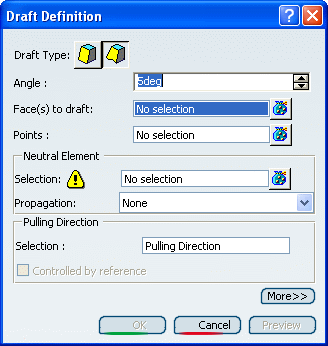
Select the face that you want to draft.
Warning: Multi-selecting faces that are not continuous in tangency is not allowed for this command. Select the upper face as the neutral element.
An arrow appears on the 3D shape, indicating the default pulling direction. The application detects two vertices and displays two identical radius values.
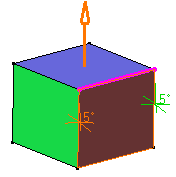
Increase the angle value: only one value is modified accordingly in the geometry.
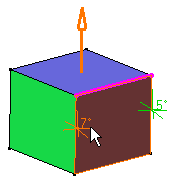
To edit the other angle value, select the value in the geometry and increase it in the dialog box. For instance, enter 9.
Tip: Alternatively, double-click this value to display the Parameter Definition dialog box, then edit the value. Click Preview to see the draft to be created.
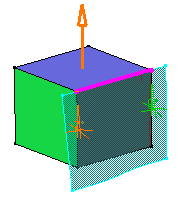
To add a point on the edge, click the Points box.
Click a point on the edge. The application displays the angle value on this point.
- You can add as many points as you wish. You can also add points by selecting 3D planes or 3D points. In this case, the application computes the intersections between these planes and the edge to determine the useful points or the projections onto the edge.
- If after clicking the points of interest, you decide to change the faces to draft or the neutral element, the application removes the points and lets you define points again.
- Note that to remove a point from the selection, you just need to click this point.
- Contextual commands creating the points you need are
available from the Points box:
- Create Point: For more information, see Generative Shape Design User's Guide: Creating Wireframe Geometry: Creating Points.
- Create Midpoint: Creates the midpoint of the line you select
- Create Endpoint: Creates the endpoint of the line you select
- Create Intersection: See Generative Shape Design User's Guide: Creating Wireframe Geometry: Creating Intersections.
- Create Projection: See Generative Shape Design User's Guide: Creating Wireframe Geometry: Creating Projections.
- Create Plane: See Generative Shape Design User's Guide: Creating Wireframe Geometry: Creating Planes.
If you create any of these elements, the application then displays the corresponding icon in front of the Points box. Clicking this icon enables you to edit the element.
Enter a new angle value for this point: for example, enter 17. The new radius value is displayed.
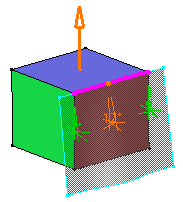
Click OK to confirm. The final drafted 3D shape looks like this:
